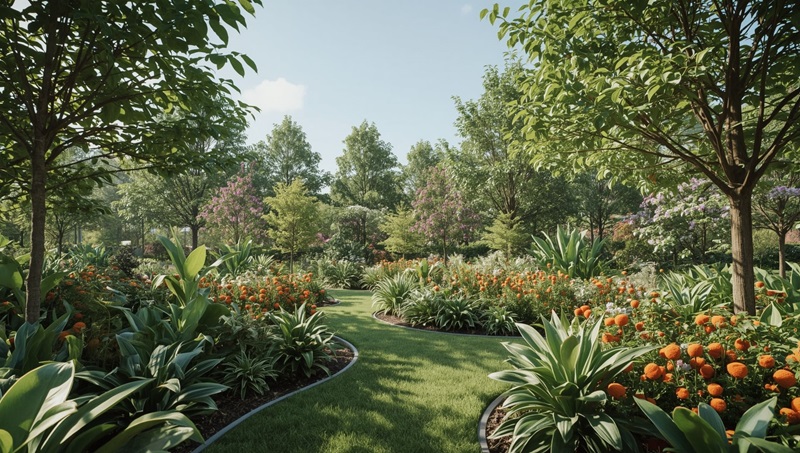The Problem With Traditional Landscaping
Landscaping looks beautiful, but it comes with a hidden environmental cost. According to the EPA’s WaterSense program, U.S. homes use more than 8 billion gallons of water outdoors each day. Nearly one-third of that goes to landscape irrigation.
For the average suburban lawn, 10,000 gallons of extra water beyond rainfall may be used each year (CED Engineering). Traditional methods also bring other issues:
- Non-native plants often fail to support local wildlife.
- Over-irrigation and fertilizers degrade soil health.
- Gas-powered equipment adds carbon emissions.
- Fertilizer and pesticide runoff pollutes waterways.
Why AI Matters in Sustainable Landscaping
Artificial intelligence (AI) is giving designers, landscapers, and homeowners new tools to make outdoor spaces greener. A survey on AI in landscape architecture (arXiv) notes that AI can analyze and predict how designs affect water, soil, biodiversity, and climate impacts.
With AI, it’s possible to design spaces that are both beautiful and environmentally smart, while also saving money in the long run. AI for landscape design is fundamentally changing the way professionals and homeowners create environmentally conscious outdoor spaces, offering unprecedented opportunities to minimize resource consumption while maximizing ecological benefits.
Intelligent Resource Management
AI can process huge sets of environmental data: climate patterns, soil type, rainfall, and more. With that, it recommends layouts and plantings that cut water use but still look appealing.
For example, platforms like Paintit.ai let users upload photos of their yards. The system then suggests designs that match both personal style and eco-friendly practices. According to the company, water use can drop by up to 75% compared to traditional landscaping.
Precision Plant Selection
AI also helps pick the right plants. Native species are usually best for the environment because they:
- Need 50–80% less irrigation than non-native plants.
- Support local pollinators and wildlife.
- Capture carbon—prairie plants, for example, can store about 1 ton of carbon per acre each year (Grow Native).
By analyzing soil, rainfall, and temperature data, AI can create planting plans that balance beauty and biodiversity.
Smart Irrigation and Maintenance
AI isn’t only for design—it also helps with daily upkeep. Smart irrigation systems use sensors and machine learning to track soil moisture and weather forecasts. They adjust watering schedules automatically, which means:
- 30–50% less water used
- Less risk of plant disease from overwatering
- Healthier soil with fewer chemicals
- Early detection of plant stress using computer vision
These tools make landscapes more resilient while reducing costs.
Economic Benefits of AI-Driven Design
Eco-friendly landscapes save money over time. Efficient irrigation lowers water bills by thousands of dollars. Native plants need less fertilizer, fewer replacements, and less labor.
AI simulations also reduce mistakes. By testing how plants will grow and interact before planting, designers avoid costly redesigns or failed landscapes later.
Enhancing Biodiversity With AI
AI can model how different design choices affect local ecosystems over time. This makes it easier to restore habitats instead of damaging them. For example, AI can predict how:
- Flowering plants support pollinators throughout the year.
- Native grasses improve soil structure and carbon storage faster than trees.
- Plant corridors connect fragmented wildlife habitats.
Research from Honeywood Garden Design shows pollinator gardens increase urban carbon storage potential. All Native Seed found native grasses and forbs establish quickly, speeding up their carbon capture benefits.
Challenges to Implementation
AI has promise, but there are hurdles:
- Data quality: AI needs accurate local climate and soil data to work well.
- Education: Many homeowners and landscapers need training to use AI tools.
- Blending tech with expertise: AI works best when paired with human knowledge and local experience.
Looking Ahead: The Future of Intelligent Landscaping
The next generation of AI landscaping may include:
- IoT sensors and satellite imaging for real-time monitoring.
- Predictive maintenance, spotting plant stress before it spreads.
- Climate adaptation features that adjust plant choices as weather shifts.
- Neighborhood-level planning, where yards connect into larger green corridors.
Conclusion
AI-powered design gives us a chance to rethink landscaping. Instead of draining water and damaging ecosystems, our outdoor spaces can work with nature.
By analyzing data and suggesting smarter solutions, AI helps create yards and gardens that:
- Save water and money
- Improve soil and biodiversity
- Store carbon and support pollinators
The technology already exists. The real question is whether we’ll use it to build landscapes that heal the environment instead of harming it.




